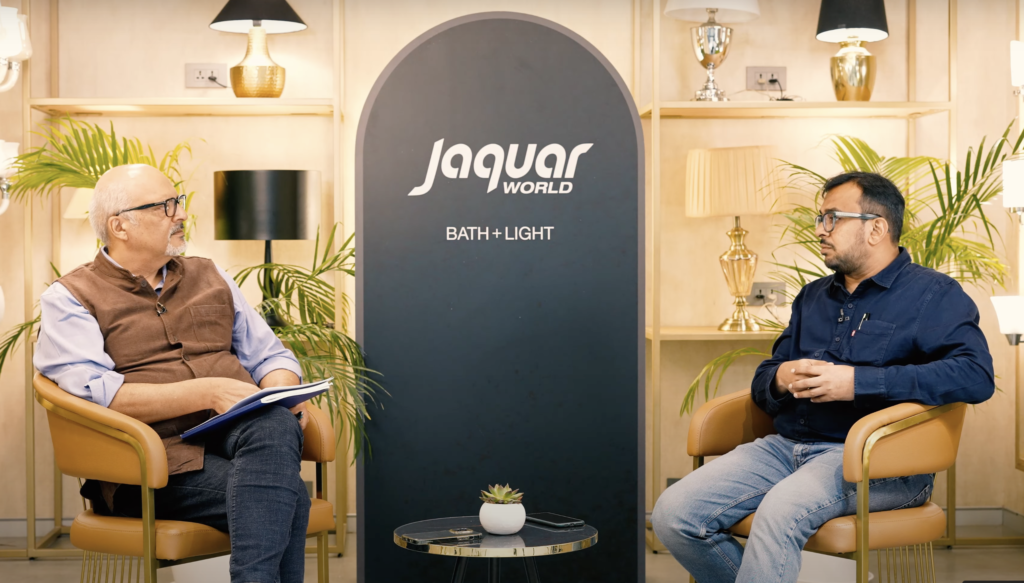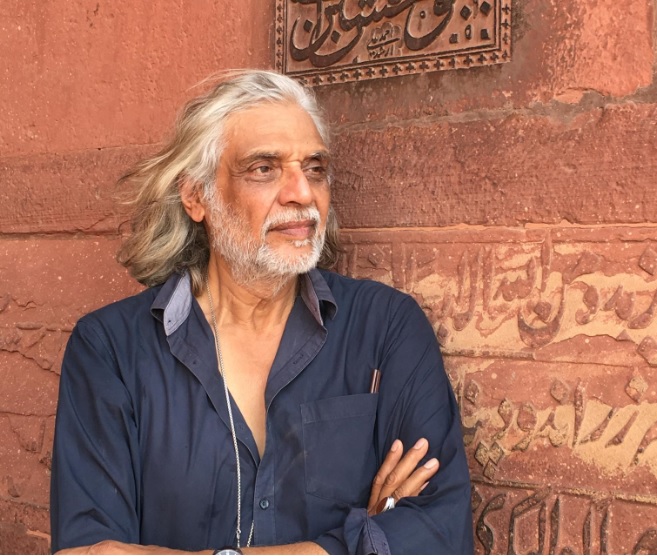Welcome to Samvaad, where art meets conversation, and inspiration knows no bounds. Here we engage in insightful conversations with eminent personalities from the art fraternity. Through Samvaad, Abir Pothi aims to create a platform for thought-provoking discussions, providing readers with an exclusive glimpse into the creative processes, inspirations, and experiences of these creative individuals. From curating groundbreaking exhibitions to pushing the boundaries of artistic expression, our interviews shed light on the diverse perspectives and contributions of these art luminaries. Samvaad is your ticket to connect with the visionaries who breathe life into the art world, offering unique insights and behind-the-scenes glimpses into their fascinating journeys.
In this enlightening conversation (SAMVAAD), we delve into the intricate intersection of architecture, art, and urban design with Vishal Shah, a seasoned architect and passionate educator. Through an engaging dialogue, Vishal shares his insights on the potential of architectural projects, the importance of integrating art into urban spaces, and the dynamics of collaboration between disciplines. From revitalising historical landmarks to fostering creative discourse in the community, Vishal offers a glimpse into his journey as both a practitioner and a teacher, shedding light on the evolving landscape of design in contemporary society. Join us as we explore the blend of tradition and innovation, the essence of creative partnerships, and the role of architects as catalysts for positive change in our built environment. Joining us for this insightful conversation is Nidheesh Tyagi from Abir Pothi, as we uncover the visionary insights driving the creative force behind Vishal Shah’s design landscapes.
Nidheesh: Vishal, could you take us through your personal journey and talk about the projects you’ve been involved in?
Vishal: this one that I was talking about, the Redevelopment of the lake of Gopi Talav, was one project which was very historical. The lake was lost in this whole urbanisation thing, and then we kind of resurrected it. The rebirth of that lake happened, and it is right now one of the most visited spaces in the city. Of course, a lot of people from around the region also come there, and it has also brought a lot of environmental benefits to the immediate surrounding area. that’s one project that most of the people in the city know, and that’s one thing for which I had to work relentlessly for almost more than 15 years, 15 or 16 years, to actually make it happen. That’s where my association with public projects and my association with Surat comes in at the forefront. Then, parallelly, we also work on a lot of other projects. Like, there’s another very interesting project that we did, which was a stretch on the Dumas entry. there was a statue of our ex-prime minister Moraji Desai at a roundabout, and there was a World War II Memorial, which was an anchor, a large anchor. We, in Gujarati, call it “lunger.” Yeah, so “lunger” and this place were 500 meters away, and we were given a very mundane brief of redeveloping that patch, or rather, not even the patch, the circle only. redevelopment, but when we said okay, now this is the entire entry point, and let’s make something which is interesting and which people look forward to coming to. that particular stretch was almost 500 meters but only had a width of 4 meters. what we thought was let’s make some very interesting art installations over there, and then we kind of went into the history of Dumas and what should we represent over there and all.
The fisherman community, which is the predominant community of that place, we started kind of taking objects like boats and waves and those kinds of things, and we started creating installations that were interactive. with all the given constraints of working on a public project wherein, you know, it’s very difficult to find space for art as, you know, a tender item, so we had to work the other way around. we designed things, and then we kind of thought that okay, how does this fit in in terms of, in a very mundane kind of a tender process, and then, we kind of started detailing those things. That is another very interesting project where we have multiple installations which have become photo ops for people to be there. In fact, when we were doing a small interview session over there, just recording about the experience of the project, we had a group of people who came from the fisherman community, and they were all dressed up, and they were all health enthusiasts and all dressed up in their gym clothes and all. We just curiously asked them, what are you guys doing here? Why are you all in the same clothes and all? They told us that this was the first time that we had been represented in a public space, and there was nothing written over there or nothing is there in terms of explanation of all these things as a write-up, but common people could feel that.
We were also quite surprised, and, we were happy that okay, the message that as designers we want to give or the purpose of the arts and the installation that is there to kind of connect to people has been served. As you were talking about the maritime thing, fishermen and sailors and, you know, traders have been the backbone of the making of the cities, and over a period of time, maybe traders still kind of evolve a lot, but fishermen and sailors and all these people, they were way marginalised and left behind. Here they get a representation.
I feel that in public spaces al this kind of thing makes a big difference. since you have asked me about projects, this was another project where we were able to do that. Similarly, a lot of public projects we have been doing, and we try to bring in this qualitative aspect into that, that we need to deliver qualitative public spaces. As far as the private projects are concerned wherein we are making bungalows or apartment interiors or even institutional buildings, there it kind of becomes more specific to the user, more specific to what you want to represent as a family or as a trust or as an institution. there we kind of bring a lot of artwork, and we tie up with a lot of artists as an integral part of our design process and not something that comes at the end. it’s not something where that is just for decorative purposes but also has to have some sort of meaning.
Nidheesh: True! The other thing I wanted to ask was, how Surat or I mean these new cities basically — I mean Surat is not a new city, but new in the sense that they started from a non-metropolitan kind of space — now aspiring to be, you know, one of the global addresses. there’s always this fine balance between retaining that old character and then also being relevant in this globalized kind of part of the global village kind of thing. how is that happening in Surat?
Vishal: This is one of my favourite phrases, which is “change and continuity.” I think both these things are very important for the vitality of any city. You cannot be so stagnant that you are museumised, and at the same time, you cannot be so non-conforming to what you are and completely lost or uprooted from what you were. there have to be certain things that need to be carried forward, and there are certain things that need to change with time for the purpose of relevance. I think Surat comparatively is doing that quite in a balanced way, is what I feel. what it is retaining is this openness, this absorption of culture, this absorption of new things, but still, it retains its small city character or a small-town character wherein you know everyone, though the population that we are talking about, 7 million odd people living in this, is not the kind of population wherein you can know each other, but still, you know, when we look at the community, it’s quite a close-knit community.
Of course, there are challenges because there are different communities, different regional people who are kind of living over here, but some or the other, how the what we say the feature of this place is such that everybody starts kind of melting into this spot. that is where I feel Surat is trying to strike a balance between change and continuity. The change that is happening is, as I already mentioned, the governance part, the self-propelled economy part, is trying to kind of bring that change from within. rather than it being kind of guided from outside, imposed upon it, it is trying to kind of come up with its own ways of dealing with these things.
Nidheesh: And being a trader maritime kind of a town, I mean, there is an inherent cosmopolitanism in the city.
Vishal: Very much, very much, yes. So that is where I feel Surat has always been. If you see the development of Surat that has happened after 1970, for a long time it was constrained within the old city, which is approximately 8 square kilometres of area. And then, in the last 50 years, if you see, it has kind of now almost, you know, 50 times what it was. that’s how the speed of development has happened, both in terms of its area and both in terms of its population. I think this explosion, and there is always a debate that also keeps on happening, what is the optimum size of a city that has to be. Should it keep on growing?
Nidheesh: I feel, should the same city be ever-growing, or should we have more cities coming up, and with their own everything spaced out? I feel now Surat is at that point wherein it has to think of that. you, but as an Urban Design expert, what do you think about? I mean, I think India has that problem. I mean, we don’t actually have, I think, with the last townships which we had like, you know, I come from Chhattisgarh, and I lived in Chandigarh and Bhilai and Rourkela, there are not many new cities coming in, and that kind of builds lots of pressure on the existing. each city becomes a bit of, there are not too many places to go, and that way…
Vishal: And the dichotomy of this whole thing is that there are cities within the cities, true. you know, when the cities become so large, you are only concerned about a certain part of the city. All your references and everything are in that part of the city itself, whether it is your friends, your family, your schools, your anything. And like, the way you go once in a while, once in a month to a different city, similarly, you go to a different part of the city, so that’s also there. personally, when you are asking my advice, I feel that there has to be a certain size of the city beyond which the physicality of the city should not grow. The solution of it I am right now not very sure.
To be continued…..





